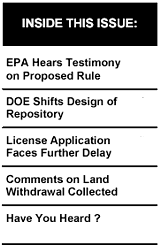EPA Hears Testimony on Proposed Radiation Rule
 he Environmental Protection Agency (EPA) held several public hearings in October in order to collect public comments on its revised Yucca Mountain radiation standard. he Environmental Protection Agency (EPA) held several public hearings in October in order to collect public comments on its revised Yucca Mountain radiation standard.
 Both supporters and critics of the radiation standard turned out to voice their concerns at a series of five hearings held in Amargosa Valley, Las Vegas, and Washington, D.C. A court ruling in 2004 overturned EPA’s original rule and sent the agency back to thedrawing board to develop a new radiation safety standard for the proposed repository.
In August of this year, EPA unveiled its new rule, which includes a two-part standard. Under the new rule, the surrounding population cannot be exposed to more than 15 millirems of radiation for up to 10,000 years. After 10,000 years and up to the one million year mark, the exposure limit is raised to 350 millirems. EPA must collect and consider public comments before issuing its final versionof the rule.
Both supporters and critics of the radiation standard turned out to voice their concerns at a series of five hearings held in Amargosa Valley, Las Vegas, and Washington, D.C. A court ruling in 2004 overturned EPA’s original rule and sent the agency back to thedrawing board to develop a new radiation safety standard for the proposed repository.
In August of this year, EPA unveiled its new rule, which includes a two-part standard. Under the new rule, the surrounding population cannot be exposed to more than 15 millirems of radiation for up to 10,000 years. After 10,000 years and up to the one million year mark, the exposure limit is raised to 350 millirems. EPA must collect and consider public comments before issuing its final versionof the rule.
About 75 people attended the October 4th hearing in Las Vegas, where representatives for Senator Harry Reid (DNev.) and Congressman Jim Gibbons (R-Nev.) delivered statements. According to Shannon Raborn, spokesman for Senator Reid, “EPA’s standard is wholly inadequate, does not meet the law’s requirements and does not protect the public health.” In a written statement, Representative Gibbons stated that “the EPA has an obligation to protect public safety today, tomorrow and in a million years.
It should not speculate that a standard which is not deemed safe today could miraculously become a safe standard in the future.”
 Ian Zabarte, a spokesman for the Western Shoshone, also testified at the October 5th meeting.
According to Zabarte, the EPA’s new standard does not take into account the lifestyles and diets
of Native Americans who thrive off the land and value the Yucca Mountain site as sacred. “Right
now, a particular class of people are being disenfranchised,” he said.
Ian Zabarte, a spokesman for the Western Shoshone, also testified at the October 5th meeting.
According to Zabarte, the EPA’s new standard does not take into account the lifestyles and diets
of Native Americans who thrive off the land and value the Yucca Mountain site as sacred. “Right
now, a particular class of people are being disenfranchised,” he said.
Several critics testified that EPA should strike down its current proposal and produce a standard
that would extend the protections for the first 10,000 years to the one million year mark.
Critics also advocated for a more stringent standard for groundwater.
Lois Gibbs, executive director of the Center for Health, Environment, and Justice, testified at
the Washington hearing. She argued that the two-tiered standard is not protective enough in the
post 10,000-year period. “EPA’s proposed standards do not prevent serious harm, they cause serious
harm,” Gibbs said.
Supporters of the new standards also testified at the hearings. Bill Vasconi, a proponent of the
proposed nuclear waste repository, pointed out that more people will be killed by car accidents and lightning strikes than will die from the radiation releases allowed under the new standards.
Jan Cameron, chairwoman of the Amargosa Valley Town Advisory Board, said that there was little likelihood of danger from Yucca Mountain. According to Cameron, the residents of Amargosa Valley have “very little concern about the increase in radiation.” However, she also noted that “it doesn’t mean there shouldn’t be monitoring and they shouldn’t be keeping an eye on it.”
Steven R. Kraft, a representative of the pro-Yucca Nuclear Energy Institute, testified at the hearing in Washington. According to Kraft, extending the radiation standard beyond 10,000 years is not a good idea. “Implementation of the disposal program should not be delayed while scientists, engineers, and regulators speculate about what might happen one million years from now,” he said.
Eureka County submitted written comments stating that, “The (EPA) rule should be written to protect public health and safety rather than to accommodate the many flaws in the site, and the site’s inability to contain the radiation.” EPA has not indicated when the final rule will be issued.
|

